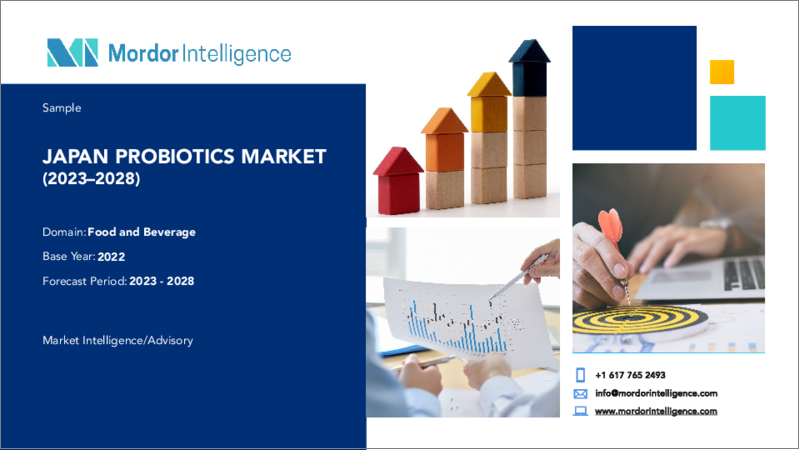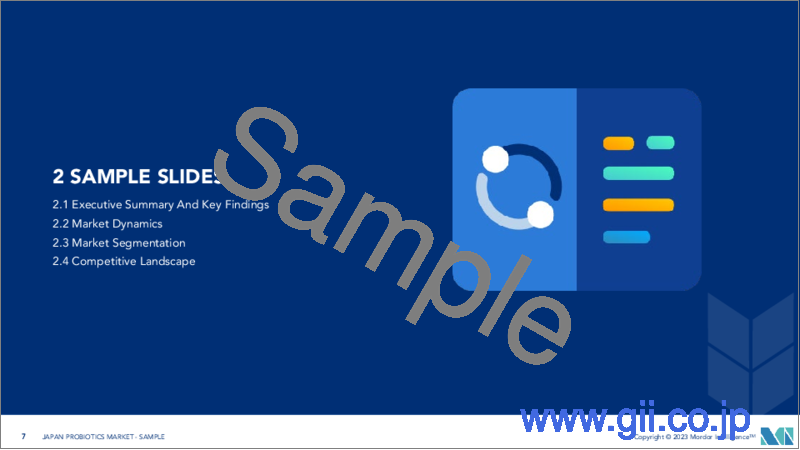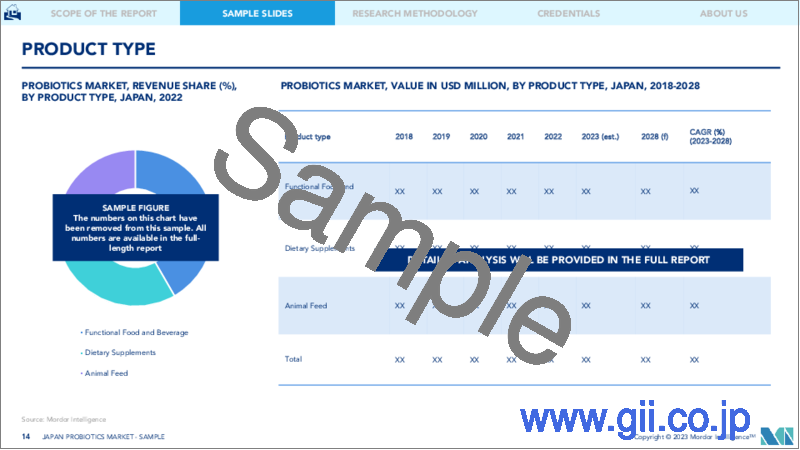|
|
市場調査レポート
商品コード
1200906
日本のプロバイオティクス市場- 成長、動向、予測(2023年-2028年)Japan Probiotics Market - Growth, Trends, and Forecasts (2023 - 2028) |
||||||
|
● お客様のご希望に応じて、既存データの加工や未掲載情報(例:国別セグメント)の追加などの対応が可能です。 詳細はお問い合わせください。 |
|||||||
| 日本のプロバイオティクス市場- 成長、動向、予測(2023年-2028年) |
|
出版日: 2023年01月23日
発行: Mordor Intelligence
ページ情報: 英文 85 Pages
納期: 2~3営業日
|
- 全表示
- 概要
- 目次
日本のプロバイオティクス市場は、予測期間中(2023年~2028年)にCAGR8.6%で成長すると予測されています。
プロバイオティクス市場は、主に免疫健康システムにおけるプロバイオティクスの重要な役割により、プラスの影響を受けています。プロバイオティクス製品は、COVID-19の流行の下、日本でもよく売れています。ヤクルト本社によると、ヤクルトブランドのプロバイオティクス製品の前年同月比売上高は、2020年3月に11.5%、4月に10.3%増加しました。また、プロビとダノンSAはCOVID-19の混乱の中、プロバイオティクス市場の成長を撃つ。
日本の消費者はプロバイオティクスの売上を強力に牽引しており、プロバイオティクス製品の長期消費者が比較的多いこともあって、アジア太平洋地域の主要な市場シェアを占めています。日本の規制では、プロバイオティクス製品は特定保健用食品(FOSHU)という明確なカテゴリーに分類されています。
日本におけるラベル表示のための強化された規制クレームは、市場の成長を合理化しています。例えば、プロバイオティクス製品の効能を表示することは禁止されており、効能を表示する場合は、厚生労働省から特別な許可を得て、その製品を特保とみなす必要があり、そのためには効能と安全性の立証が必須要件となっています。
日本のプロバイオティクス市場動向
国内におけるプロバイオティクスの高い消費率
日本の伝統によれば、プロバイオティクスの原料や最終製品の開発は、科学的証明に基づき、実証された日本人の健康要件に支えられています。日本の消費者は腸内細菌叢を定期的に補充することを強く意識しており、プロバイオティクス細菌を最良の解決策と認識し、国内のプロバイオティクス市場をさらに牽引しています。プロバイオティクス・ヨーグルトや飲料は広く販売されており、多忙な日本の労働者にとって理想的な健康的軽食となっています。日本は、世界全体、特にアジア太平洋地域におけるプロバイオティクス市場の収益において、リーダーの一角を占めています。
市場を牽引する栄養補助食品
日本では、高齢者人口の増加に伴い、栄養補助食品、機能性食品、飲食品が市場を牽引し、大きな成長を遂げています。さらに、乳糖不耐症や炎症性腸疾患の予防と治療は、プロバイオティクスが提供する利点の一部であり、健康意識の高まりとプロバイオティクス栄養補助食品への幅広いアクセスは、将来的に市場の成長をさらに促進すると予想されています。需要が拡大しているため、メーカーは需要を獲得し、市場での競合優位性を獲得するための製品開発に注力しています。例えば、2019年にキリンビバレッジ株式会社は、同社独自のプロバイオティクスであるラクトコッカス・ラクティス株プラズマを配合した「iMUSE Water(水)」を発売しました。プラズマ乳酸菌は免疫に関与していることが判明し、デングウイルス感染症対策やアンチエイジング効果など、大きな可能性を秘めています。
その他の特典
- エクセル形式の市場予測(ME)シート
- 3ヶ月間のアナリストサポート
目次
第1章 イントロダクション
- 調査の前提条件と市場の定義
- 調査対象範囲
第2章 調査手法
第3章 エグゼクティブサマリー
第4章 市場力学
- 市場促進要因
- 市場抑制要因
- ポーターのファイブフォース分析
- 新規参入業者の脅威
- 買い手/消費者の交渉力
- 供給企業の交渉力
- 代替品の脅威
- 競争企業間の敵対関係
第5章 市場セグメンテーション
- 製品タイプ別
- 機能性食品・飲食品
- 栄養補助食品
- 動物用飼料
- 流通チャネル別
- スーパーマーケット/ハイパーマーケット
- 薬局・健康食品店
- コンビニエンスストア
- その他
第6章 競合情勢
- 最も活発な企業
- 最も採用されている戦略
- 市場シェア分析
- 企業プロファイル
- Yakult Honsha Co. Ltd
- Moringa Milk
- Groupe Danone
- Nissin Food Products Co., Ltd.
- Meiji Co.
- BioGaia
- Nestle SA
- General Mills
- Glac Biotech
- Asahi Holdings
第7章 市場機会と将来動向
第8章 COVID-19が市場に与える影響
The Japanese probiotics market is forecasted to grow at a CAGR of 8.6% during the forecast period (2023 - 2028).
The probiotics market is experiencing a positive impact mainly due to the key role of probiotics in the immune health system. Probiotic products have been selling well in Japan under the COVID-19 outbreak. According to Yakult Honsha, year-on-year sales of Yakult branded probiotic products increased by 11.5% in March and 10.3% in April 2020. Also, Probi and Danone SA shoot for growth in probiotic markets amid COVID-19 disruptions.
Japanese Consumers are strongly driving the sales of probiotics in the country and thus holding a major market share in the Asia Pacific Region, benefitted by a relatively high density of long-time consumers of probiotic products. As per Japanese regulations, these probiotic products are in a distinct category, Foods for Specific Health Uses (FOSHU).
The enhanced regulatory claims for labeling in Japan are streamlining the market growth. For Instance, efficacy claims of probiotic products are prohibited on the labeling, and if to make claims about efficacy, one must obtain special permission from the Ministry of Health and Welfare (MHLW) for the product to be considered FOSHU, for which substantiation of efficacy and safety is a mandatory requirement.
Japan Probiotics Market Trends
High Consumption Rate of Probiotics in the Country
According to the Japanese tradition, the development of probiotic ingredients and finished products is based on scientific proof and supported by demonstrated Japanese health requirements. Japanese consumers have been very conscious of replenishing the bacterial flora in their gut regularly and perceive probiotic bacteria as the best solution, further driving the probiotics market in the country. Probiotic yogurts and beverages are widely available and are ideal healthy snacks for busy Japanese workers. Japan is one of the leaders in the probiotics market in terms of revenue across the globe, especially in the Asia Pacific region.
Dietary Supplements driving the market
The market has witnessed significant growth, owing to the rise in the prevalence of the geriatric population, driving the sales of dietary supplements, followed by functional foods and beverages in the country. Furthermore, prevention and cure of lactose intolerance and inflammatory bowel disease are some of the benefits offered by probiotics, with rising health-consciousness levels and wider access to probiotic dietary supplements expected to further drive the market growth in the future. Due to the growing demand, manufacturers focus on developing products to capture the demand and achieve a competitive advantage in the market. For instance, In 2019, Kirin Beverage Co. launched iMUSE Water (Mizu), containing its proprietary probiotic Lactococcus lactis strain Plasma. The Plasma Lactobacillus was found to play a role in immunity and has a huge opportunity for its potential use in fighting dengue virus infection and its anti-aging effects.
Japan Probiotics Market Competitor Analysis
The probiotic industry in Japan is competitive due to the presence of both local and major players such as Yakult Honsha, Meiji, and Morinaga, which have been continuously seeking to expand their presence. Danone holds a 20% interest in Yakult's equity, one of the leading brands for probiotics in Japan and Asia. This partnership has increased both companies' market share.
Additional Benefits:
- The market estimate (ME) sheet in Excel format
- 3 months of analyst support
TABLE OF CONTENTS
1 INTRODUCTION
- 1.1 Study Assumptions and Market Definition
- 1.2 Scope of the Study
2 RESEARCH METHODOLOGY
3 EXECUTIVE SUMMARY
4 MARKET DYNAMICS
- 4.1 Market Drivers
- 4.2 Market Restraints
- 4.3 Porter's Five Forces Analysis
- 4.3.1 Threat of New Entrants
- 4.3.2 Bargaining Power of Buyers/Consumers
- 4.3.3 Bargaining Power of Suppliers
- 4.3.4 Threat of Substitute Products
- 4.3.5 Intensity of Competitive Rivalry
5 MARKET SEGMENTATION
- 5.1 By Product Type
- 5.1.1 Functional Food and Beverage
- 5.1.2 Dietary Supplement
- 5.1.3 Animal Feed
- 5.2 By Distribution Channel
- 5.2.1 Supermarkets/ Hypermarkets
- 5.2.2 Pharmacies/Health Stores
- 5.2.3 Convenience Stores
- 5.2.4 Others
6 COMPETITIVE LANDSCAPE
- 6.1 Most Active Companies
- 6.2 Most Adopted Strategies
- 6.3 Market Share Analysis
- 6.4 Company Profiles
- 6.4.1 Yakult Honsha Co. Ltd
- 6.4.2 Moringa Milk
- 6.4.3 Groupe Danone
- 6.4.4 Nissin Food Products Co., Ltd.
- 6.4.5 Meiji Co.
- 6.4.6 BioGaia
- 6.4.7 Nestle SA
- 6.4.8 General Mills
- 6.4.9 Glac Biotech
- 6.4.10 Asahi Holdings




